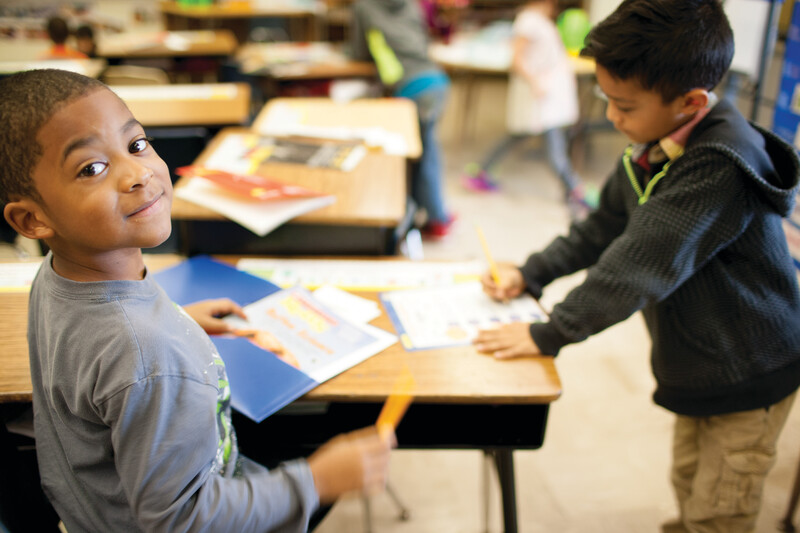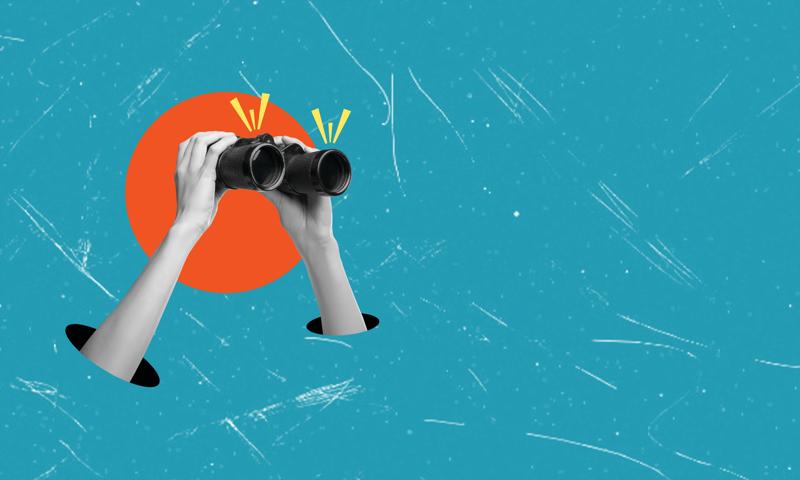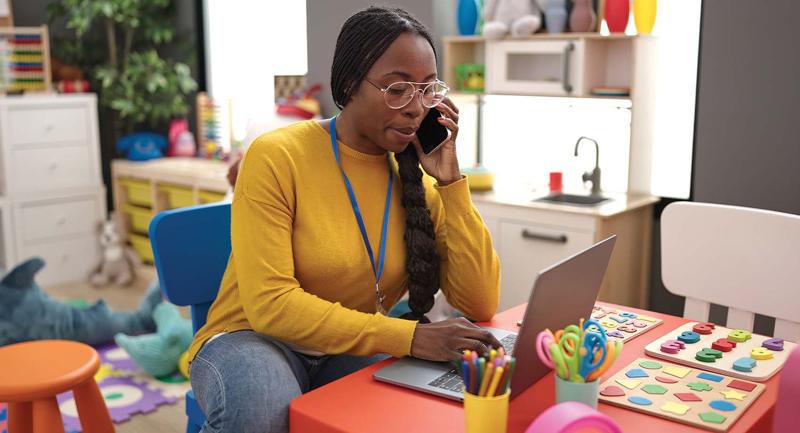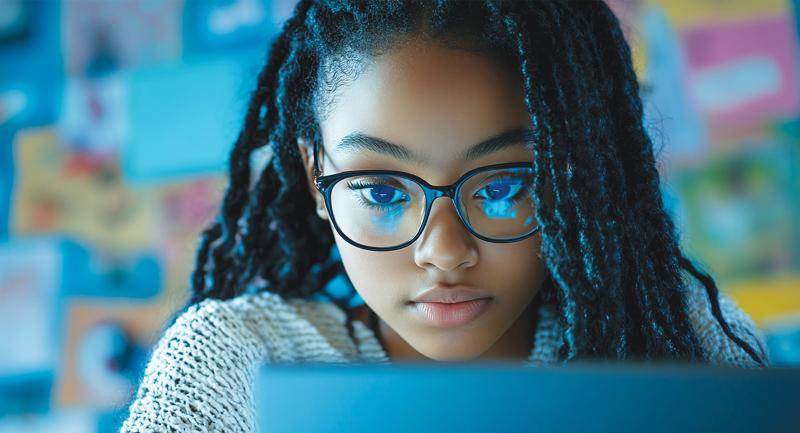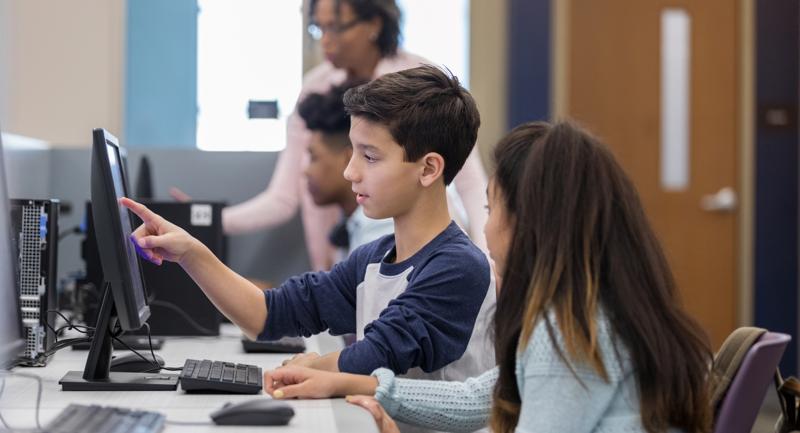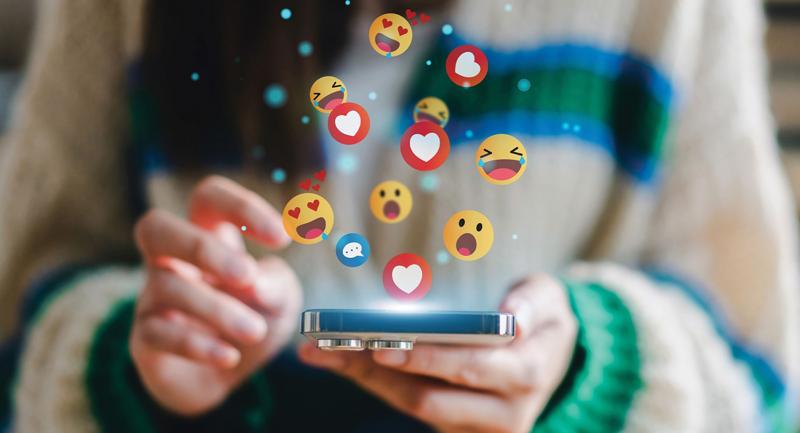I think I should add spaces next time," my 1st grade student Marlo said, referring to her writing.
Marlo came to this conclusion on her own using our student-friendly writing rubrics. These rubrics consist of a series of writing samples grouped into categories displaying various levels of proficiency. By using them, students can go through the natural process of comparing their work against other samples and making improvements in their writing—sometimes with my help and sometimes on their own.
"That's a great idea!" I replied. "I think it would make your piece easier to understand. But before you start your next piece, will you document your work?"
Marlo nodded, and I watched her walk happily to our tablet cart, retrieve her device, and excitedly take a picture, knowing her parents would see her work in just a few days. I would deposit this record of her writing in her learning portfolio. Eventually, I would assess it and other work in Marlo's portfolio against grade-level benchmarks. I would share my feedback about Marlo's progress with her parents, writing one chapter of a learning narrative that would continue to unfold over the course of the school year through updates every couple of weeks based on either informal formative assessments or formal writing benchmarks.
This anecdote paints the picture of personalization in my classroom. At this one moment, learning was personal, relevant, and student-driven. But oddly enough, this level of personalization would have been impossible if not for some standardization.
Personalization and Standardization: A False Dichotomy
To many, personalization and standardization seem antithetical. After all, personalization implies customization, something unique to each individual, whereas standardization implies something common to all. This dichotomy is limiting, especially as we emerge into an era where both approaches will be necessary to build a sustainable education model that closes achievement gaps while supporting innovation.
There's no better example to demonstrate the harmonious marriage between standardization and personalization than social media. Social media platforms allow autonomous individuals to be the protagonists of their own narrative while building relationships through likes, comments, and shares. This is how social media has grasped the collective consciousness of modern society. But this phenomenon would be impossible without a certain level of standardization; social media activity happens within a structured, regimented system.
Before we identify these standardized components and how these realities about social media can be applied to personalized learning, it's important to examine what technology does—and has always done—to make the experience of being human more connected, more relationship-driven, and most important, more personal.
How Technology Connects Us
Technology has been connecting individuals, building relationships, and increasing the empathic capital of the world since the beginning of time. Inventions that today seem archaic, like the telephone or the printing press, allowed humans to communicate over long distances and share information with others like never before. These technological systems have supported a more connected, personal experience for the human race, extending empathy across space and time.
However, these technologies also possess standardized components, many of which you and I take for granted. The printing press rearranges 26 specific letters and a handful of particular symbols in infinite ways to create an unlimited number of personalized messages. Telephones are an assortment of standard wires, conductors, and machines, creating a communication network that allows us to send personalized messages through word of mouth.
I hope it's clear by now that when I speak about standardization, I'm not referring to standardizing the experience, as one might do with a one-size-fits-all curriculum. Instead, I'm referring to standardizing tools and processes, such as giving and receiving feedback or using rubrics. Popular modern technology also uses agreed-upon processes. Facebook and Instagram have standard tools and a common language through which individuals can post pictures, comment on friends' activity, and otherwise share the unfolding narrative of our lives. It's here that the marriage between standardization and personalization becomes palpable—but not necessarily because the tools themselves are personalized. Instead, standardized tools and common language support these individuals in personalizing their own experience.
When personalization and standardization are viewed through this lens, the previously dichotomous relationship between these two constructs suddenly breaks down. There is no longer a tension between standardization and personalization, but instead a symbiotic relationship. Standardization supports personalization through its common language and strong foundation, thereby opening the door for creativity and collaboration. Personalization supports standardization by motivating individuals to push the boundaries of what they can do with the tools.
Marlo's experience of assessing her work, documenting it in a digital portfolio, and initiating improvements to her next piece of work illustrates a healthy relationship between standardization and personalization in the classroom. She was working within a common set of constraints: All students were writing stories, drawing on their understanding of a few well-defined objectives related to story structure, sequence, and foundational writing skills. The constraints used in my classroom simply serve as reference points, anchoring students by setting up a clear, common language for the level finished work should reach (standardized rubrics and grade-level benchmarks) and a reliable workflow (assess, document, and share) so students know what to expect. Each student can still experience the agency and autonomy that come as a result of meaningful constraints, such as the ability to choose what to write about or set personal learning goals and next steps.
Many in the progressive education space might see this rigorous use of assessment as antithetical to child-centered learning. However, it's necessary to set meaningful boundaries with students. Too much choice can often be more confining than meaningful constraints. Children are constantly developing a mental model for the world, and as a result, they are looking for structures on which they can rely to feel successful. Without these structures, it is incredibly difficult for most children to see the reference points that meaningful constraints can provide.
Toward a More Mindful Model
It's here that contemporary educators can learn a valuable lesson. Too frequently, personalization is defined in the absence of standardization; no class structures for learning processes are set up. As a result, we make the process of personalization more complex than it needs to be by attempting to individualize just for the sake of individualization. We have every student reading a different book or doing a different math problem when that's unnecessary. To make personalization more sustainable and meaningful, I suggest we take a more mindful approach, finding a "just-right" amount of individualization that will support personalization.
By individualization, I mean one-on-one instruction in which a student is, for all intents and purposes, functioning in isolation. Many conflate individualization with personalization, but personalization can occur in all contexts. For example, I'm currently having all my students write scripts for fable-based puppet shows, but within the context of this project I'm tailoring feedback and goals to individual kids. Students aren't working in isolation or all working on different things, but I've made the project personal to each student by taking into account his or her interests and personalizing feedback.
Our challenge is similar to that of Goldilocks. The one-size-fits-all public school system—in which classroom rules and processes, required content, and the schedule for learning content are uniform—feels "too cold." Looser models often used at private schools—with small class sizes, fewer rules, and less structure—feel a bit "too hot," frequently becoming unsustainable at scale. Rather than go to either extreme, we must, like Goldilocks, seek a degree of individualization that feels "just right."
A psychological law called the Yerkes-Dodson Law (colloquially known as the "Goldilocks Effect") states that optimal performance occurs not through maximum arousal, but through an intermediate level of stimulation (Yerkes & Dodson, 1908). In many cases, the magnitude or intensity of any single input—in this case, individualization—actually has diminishing returns. In layman's terms, it's possible to have too much of a good thing.
Similarly, many people assume that smaller class sizes necessarily mean a higher-quality education, because they allow for more individualization. This is simply not true. If it were, studies would show that individualized learning and one-on-one tutoring provide the highest effect size on student achievement, when in reality, individualized learning has been shown to have a rather small impact (Hattie, 2015). Not only is a high degree of individualization unsustainable, but it also has the potential to isolate children from their peers and rob the classroom of community-building and interpersonal learning experiences, in effect depersonalizing kids' experiences.
Instead of optimizing only for individualization, let's create a culture of personalization by standardizing carefully selected components of the classroom, finding points of convergence where students can revel in being part of a classroom community while honoring points of divergence where learning can become utterly personal.
Oddly enough, this idea has been around since the time of Jean Piaget and John Dewey, two of the fathers of progressive education. Piaget and Cook (1952) reminds us that learning is most personal when we can meaningfully assimilate new information into an already existing schema. Dewey (1938) helps us see that learning is a social, interactive, and collaborative process, much in the way social media operate today.
The Role of Adaptive Web-Based Systems
Frequently, however, we don't consider Piaget's or Dewey's theories when exploring the art of making learning personal. Instead, we rely on the Vygotskian perspective of the "just-right" level of instruction, allowing adaptive, web-based technologies to take over. We put children on Khan Academy or RazKids, assuming that by focusing on their individualized skill levels, we'll provide the highest level of personalization possible. Meta-analyses like John Hattie's 2015 study, however, show low effect sizes for web-based learning and for individualized learning, at .18 and .2, respectively.
This doesn't mean that web-based technologies cannot support the learning experience. Such technologies can support teaching and learning in personalized environments, assuming they're used to bolster communication and help individuals feel more personally connected to one another—as ground-breaking technologies have done for centuries. Take, for example, online platforms like Edmodo, a learning management system that allows students to post in forums so that all students within a class—and perhaps even some outside that classroom—can participate in a digital conversation.
Scaling Personalization through Standardization
The question of how to personalize learning, however, isn't just a matter of enabling communication and human connection; it's also a problem of complexity at scale. Allowing 20 or more children to navigate their own learning journeys naturally raises the level of complexity within a single classroom, making personalization feel impossible, especially in an era of accountability where educators must provide objective measures for student progress over time.
Education's responses to this problem of complexity have mostly been to standardize pedagogy and curricular resources, as opposed to standardizing the process by which we support individual students and their learning. Drawing on our earlier analogy, it's clear that a social media tool would never aim to standardize the content with which the user interacts. Instead, social media platforms aim to standardize the communication protocols and systems by which the user expresses his or her autonomy, shares information with others, and tells his or her own story.
This was also the case with Marlo, the 1st grader who evaluated her writing, documented her work, and continued to build the narrative of her personal learning journey. The content wasn't standardized (she wrote about a topic of her choice), nor were the curricular resources (I wasn't using a specific program to help improve students' writing). So how did standardization support her experience?
First, the process by which students evaluated their work was standardized. They knew to reflectively compare their pieces against the rubrics. I had scaffolded this thinking through a common system, helping students find their way through a balance of autonomy and teacher support.
Second, the language I used to build the rubrics was standardized, using none other than the Common Core State Standards. Talking about specific academic standards is one place where standardization becomes controversial, and where recommending standardization seems antithetical to personalization. Skepticism toward standards is grounded in a common misconception around what the word standard means. Some equate this term with standardization of the learning process or product, when in reality, a standard is merely a statement about what every student should know and be able to do at any given grade level. Common standards, if they're used poorly, can lead to all students learning similar content. However, without defining achievement at different ability levels through standards, it's impossible to close gaps in achievement or provide a reference point for what success looks like. In this respect, it's important to train educators in how to deconstruct standards to build assessment criteria and processes for reflection, helping to drive agency, autonomy, and a more personal experience.
Finally, the process by which I provided feedback was standardized. In my class, this process hinges on students' willingness to take pictures of their work and is made meaningful by my process of pointing out observable characteristics of the work, quantifying what these characteristics reflect about each learner's level of proficiency, and laying out a plan for how I'll support each learner moving forward. This structure minimizes the complexity of my work, allowing me to reach more students without more personal resources.
Toward Personal Learning
"Look, Paul!" my student Marlo exclaimed a few days later. "Look how many spaces I added, and look at all of my letters on the lines!"
Excitement beamed from her eyes, and tears welled in mine. To see her so thrilled about not only her writing, but also the progress that was visible to her, confirmed my theory that a strong infrastructure, mindfully standardized through clear communication structures and streamlined processes for feedback, could help my students feel empowered by their own learning journeys.
We aren't going to solve the problems of the 21st and 22nd centuries simply by individualizing education. Instead, we can work to create a generation of empathic problem solvers by helping students understand their own agency and autonomy, creating a learning experience for all that involves more meaning and personal connection.
Author's note: All student names are pseudonyms.
EL Online
For a discussion of using personalized learning to close opportunity gaps, see the online article "A Personalized Approach to Equity" by Becky Wilusz and Ken Templeton.




